
LONGQUAN CELADON
Celadon is a word that is synonymous to Longquan greenware. Besides blue and white, this is definitely one of the best known Chinese porcelain. It could be found in countries along the ancient maritime silk route which linked Southeast Asia, South/west Asia. middle-east and East Africa. The quantity of Longquan celadon wares exported during the Song and Yuan period was enormous.
The kilns producing Longquan celadons were located in southern Zhejiang province, covering ten counties with most kiln sites located at Longquan (龙泉), Qingyuan (庆元), Yunhe (云和), and Lisui (丽水). Longquan had the most kiln sites, among which Dayao (大窑) and Jincun (金村) produced the best quality Longquan wares during the Song, Yuan and Ming period.

Present day Dayao village
Longquan is situated in a mountainous region and access to the outside world is mainly by the river Longxi (龙溪). Longxi is the upper stream of Ou river (殴江) which flows through Wenzhou, a major port. According to an ancient text, Zhi tan ji (治滩记) by Gong Yuan (龚原), works to improve and remove the obstacles along the longxi river to facilitate navigation was finally completed in the 7th year of Yuanyou (元祐七年), ie 1092 A.D. Prior to that, Longxi was notorious for the numerous treacherous shoals, rapids and water falls which made navigation dangerous. The river clearance facilitated the transport of longquan wares to Wenzhou port and from there distribution to local and overseas markets. It was the turning point for the Longquan ceramics industry. From then onward, there was increased production and improvement to quality of its products. Longquan ware finally became a major international brand by the Late Southern Song period.
In 2021/22 the remains of the ancient Wenzhou port of Shuomen (朔门) was discovered. Preliminary surveys showed that it dated to the Song/Yuan period. Among the fragments of trade ceramics unearthed, there were large quanity of Longquan shards
 |
| The strip of land near the coast revealed the remains of the ancient Shuomen port |
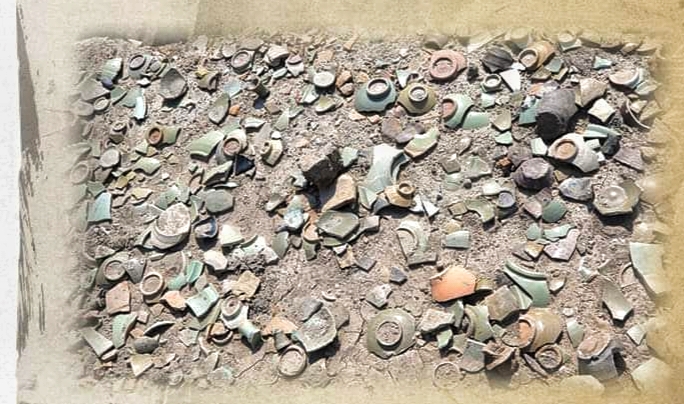 |
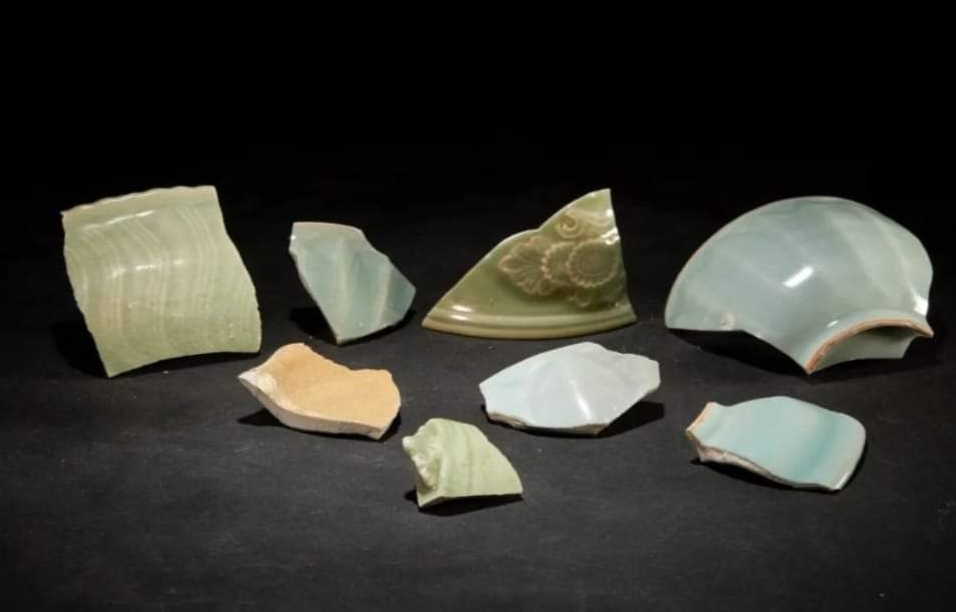 |
| Longquan celadon fragments unearthed from the Shuomen ancient port site |
Northern Song Longquan light green (淡青)glaze wares
Some experts are of the view that Longquan kilns originated during the Three Kingdoms and Western Jin based on some Yue type porcelain wares found in tombs near Longquan. However, the earliest kiln sites located so far are dated to Tang period and they are located in Lisui Lubukeng (呂步坑) and Qingyuan Huangtan (黄坦). Strictly speaking, the ceramics produced are strongly influenced by Yue wares and they are not located in Longquan county.
Based on latest archaeological kiln findings, ceramics production in Lonquan commenced in Jincun (金村) during the Northern Song period, with proposed date ranging from mid 10th to mid 11th century. The glaze of the early products is transparent light green in colour tone and akin to those from the ou kiln (瓯窑) of Wenzhou (温州). The body of those light green wares is typically thin and with fully glazed footring and base . However, there are also a small number without glaze on the outer base. The influence of contemporary Yue ware is evident. Similar incise decorative technique was used and Yue stacking technique using clay stripes on inner and outer base of vessels was adopted.
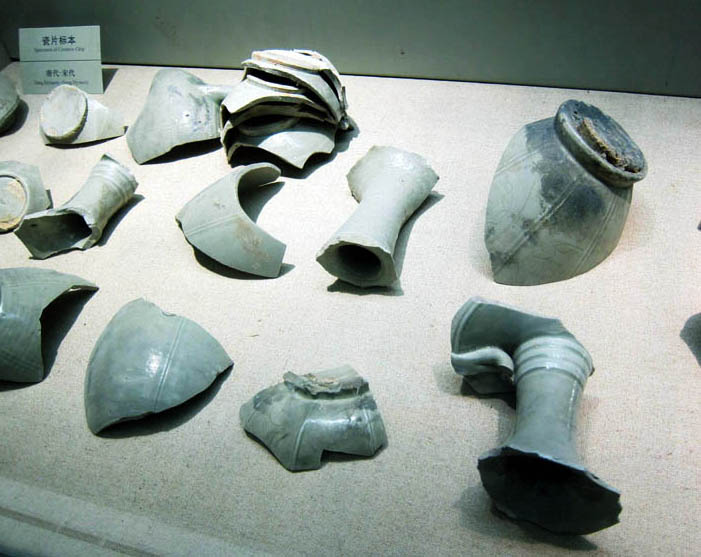
Shards of Northern Song light green glaze vessels in Longquan museum
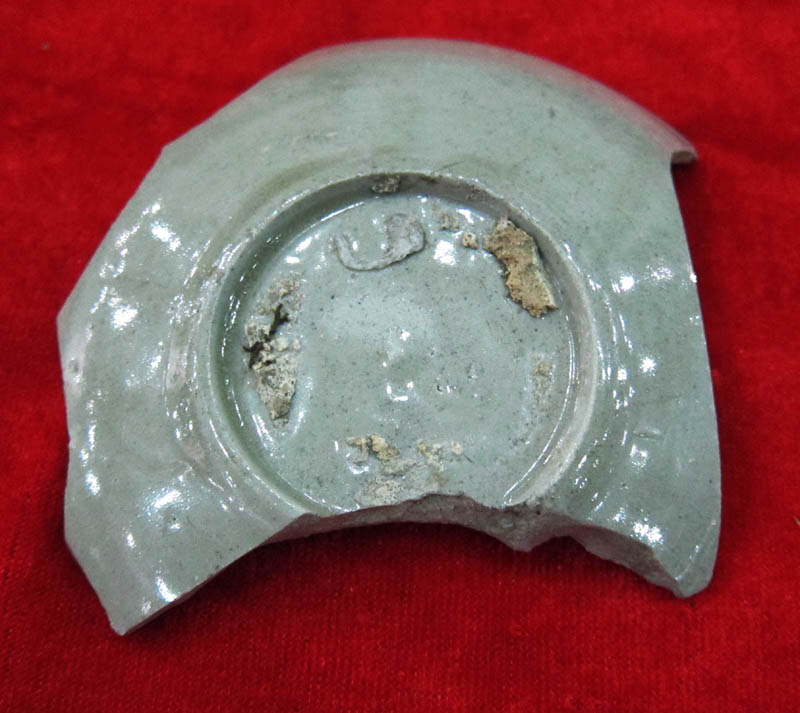
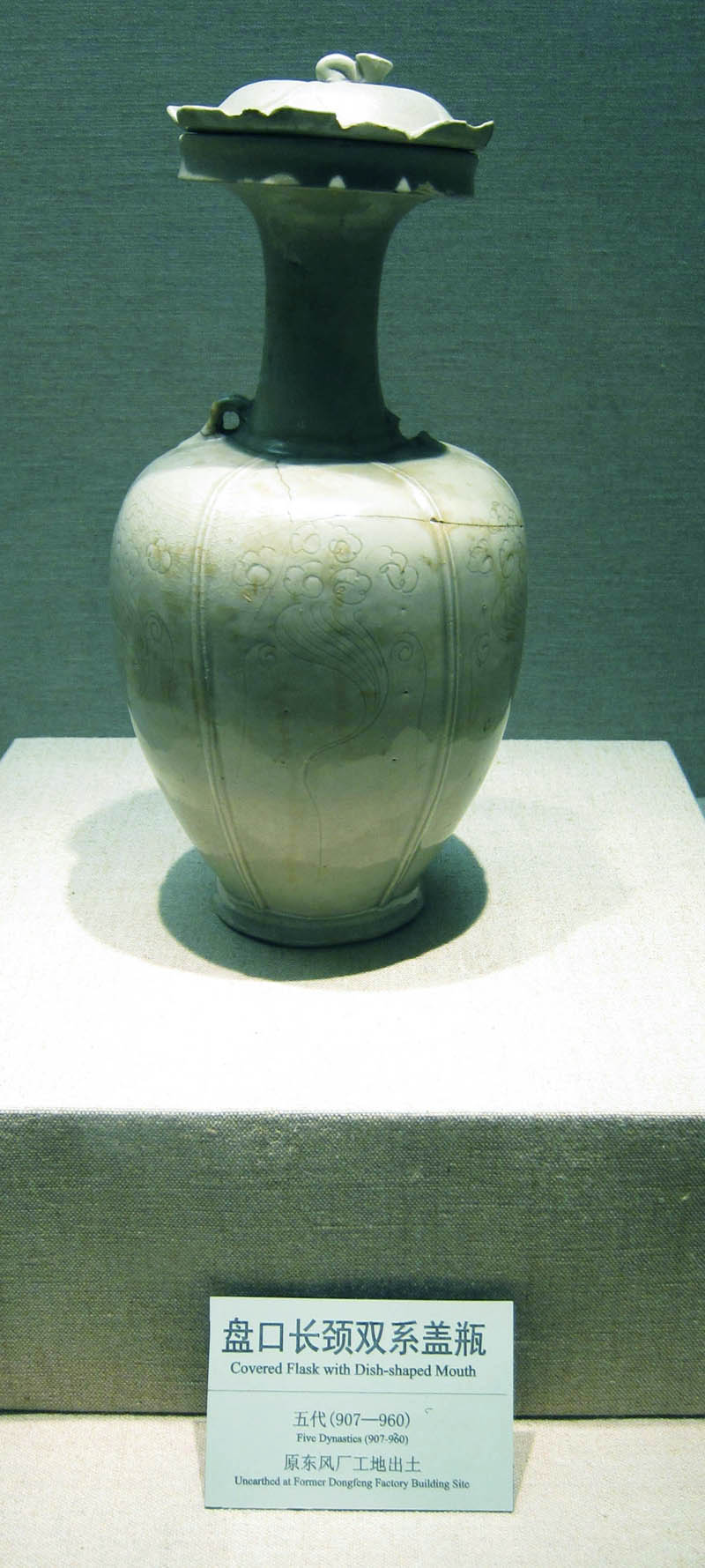
The dating of 5 Dynasties is most probably too early.
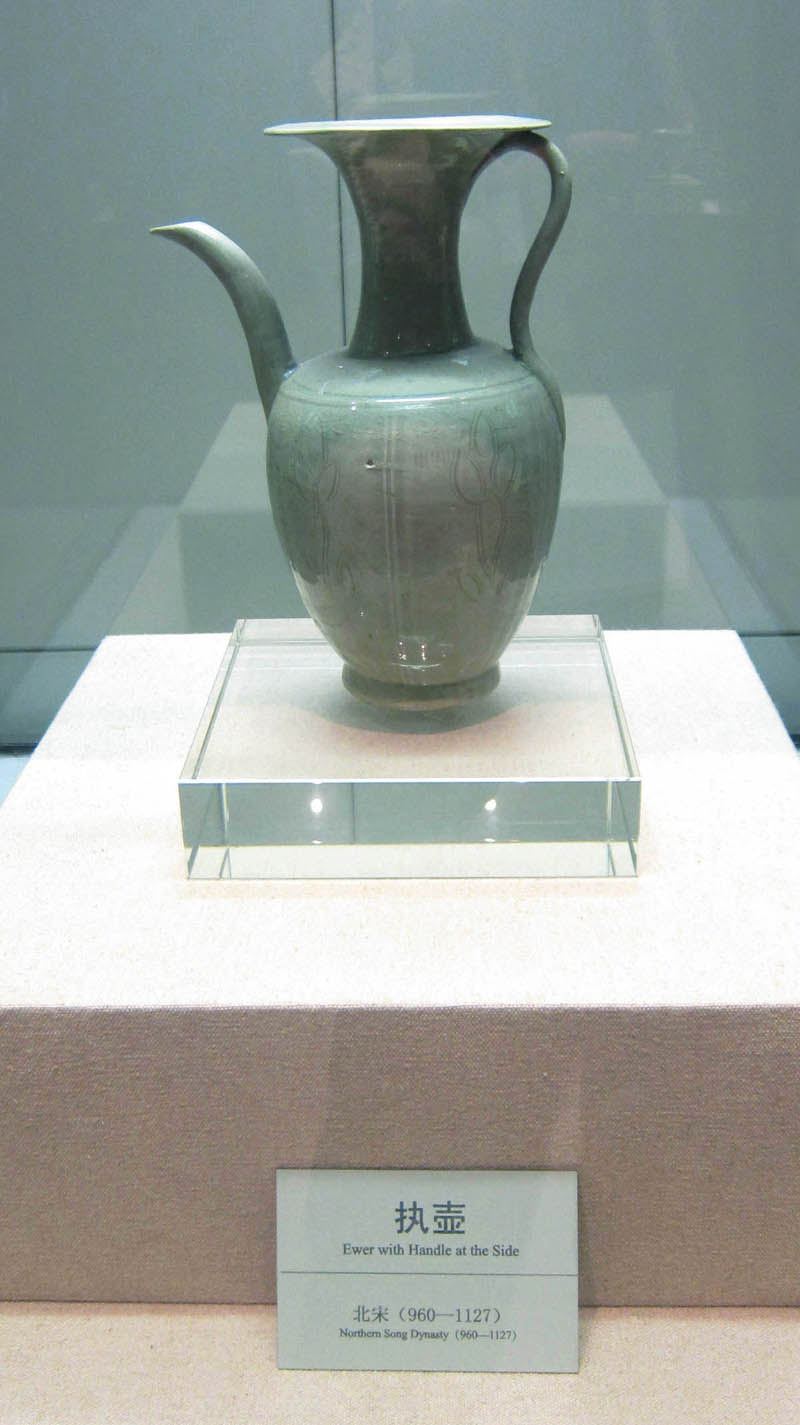
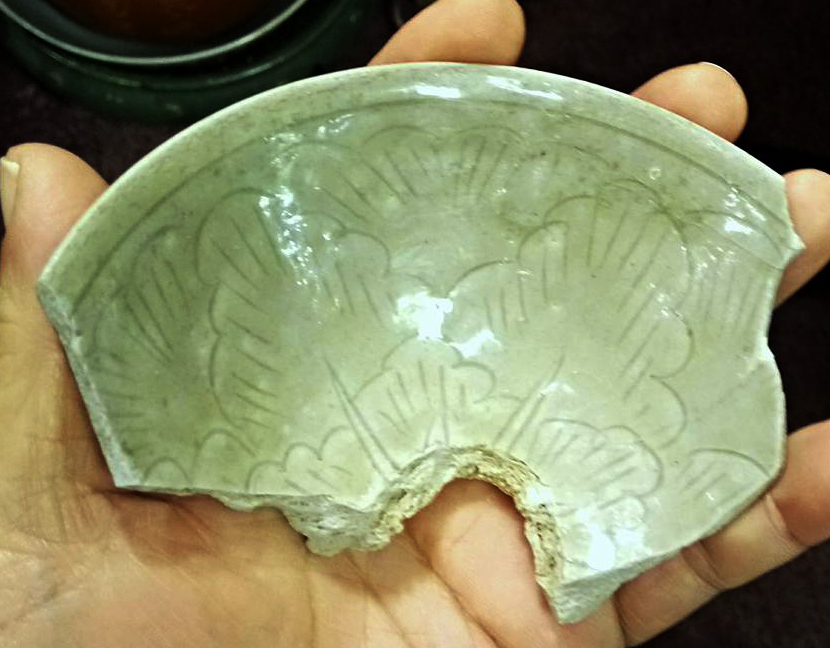
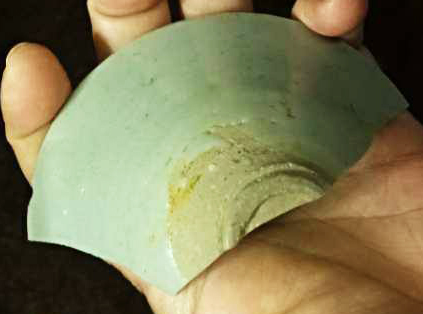
Example with carved floral decoration showing strong Yue influence
Mid to Late Northern Song Longquan wares
By Mid Northern Song, the Longquan potters started to produce wares which are distinct and distinguishable from contemporary Yue wares The biscuit is light greyish to grey in colour. It has thinly applied transparent, glassy glaze with outer base left unglaze. The glaze typically is greyish green or yellowish green. But occasionally you do find some with clear light green tone. Chemical tests showed that it is lime glaze with low viscosity. Yue style clay stripes as separator was no longer used. Instead a clay disc separator was placed on the outer base. The typical bowl has carved vertical lines on the external wall and carved/incised floral motif with combed lines/zigzag lines on the interior. An example with the vertical lines on the exterior wall was excavated from the the tomb of Li Bing couple of A.D. 1091 at Liyang, Jiangsu province.
Most Chinese archaeologists date them to Late Northern Song. However overseas findings from habitation sites (such as Dazaifu in Japan) indicates that they were also found during the early Southern Song period. Mr Kamei Meitoku, a Japanese ceramics expert, did an article on the Chronology of Longquan wares. Basing on the archaeological findings in Longquan and Japan, he suggested that those vessels with carved/combed motif were produced from late 11th to first half of 12th century, ie. late Northern Song Period to early Song period. Such bowls were also produced in Fujian Province. Those from Pucheng (浦城) in Northern Fujian bear close resemblance to that from Longquan. Bearing in mind that Pucheng is situated near the border of Zhejiang and close to Longquan, the similarity is hardly surprising. For those produced further from Northern Fujian, they can be more easily differentiated. The footring tends to be more crudely finished.
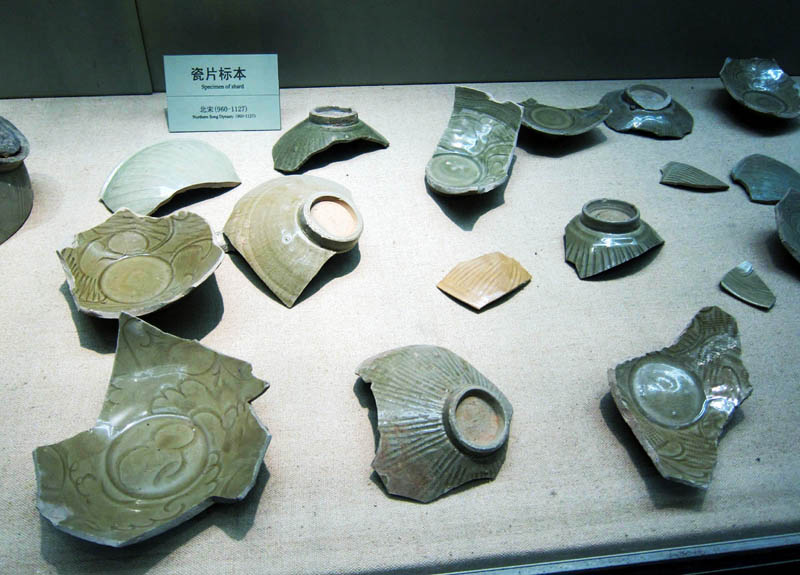
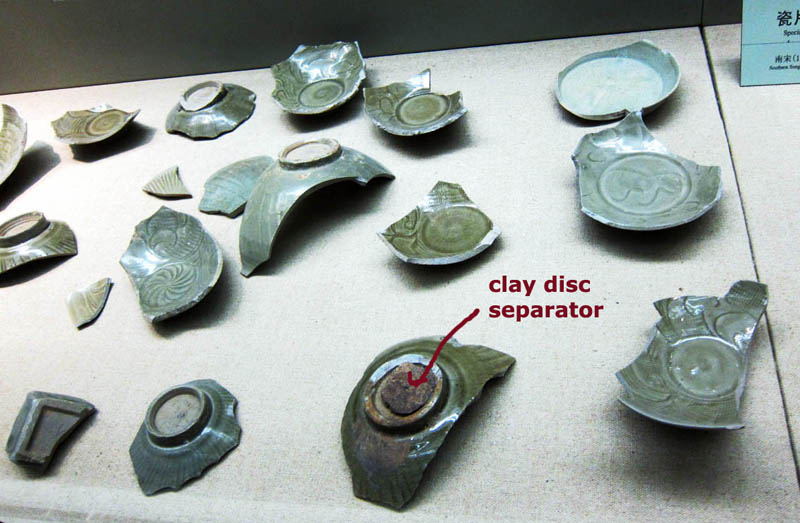
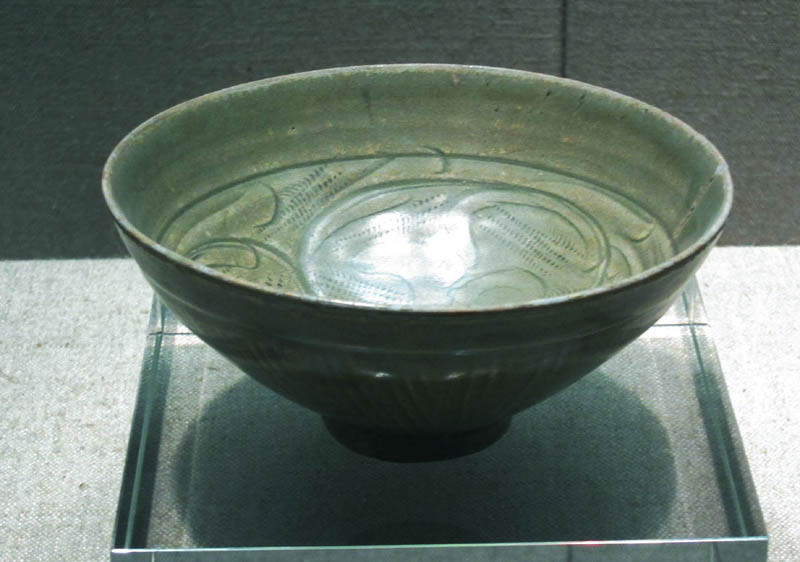
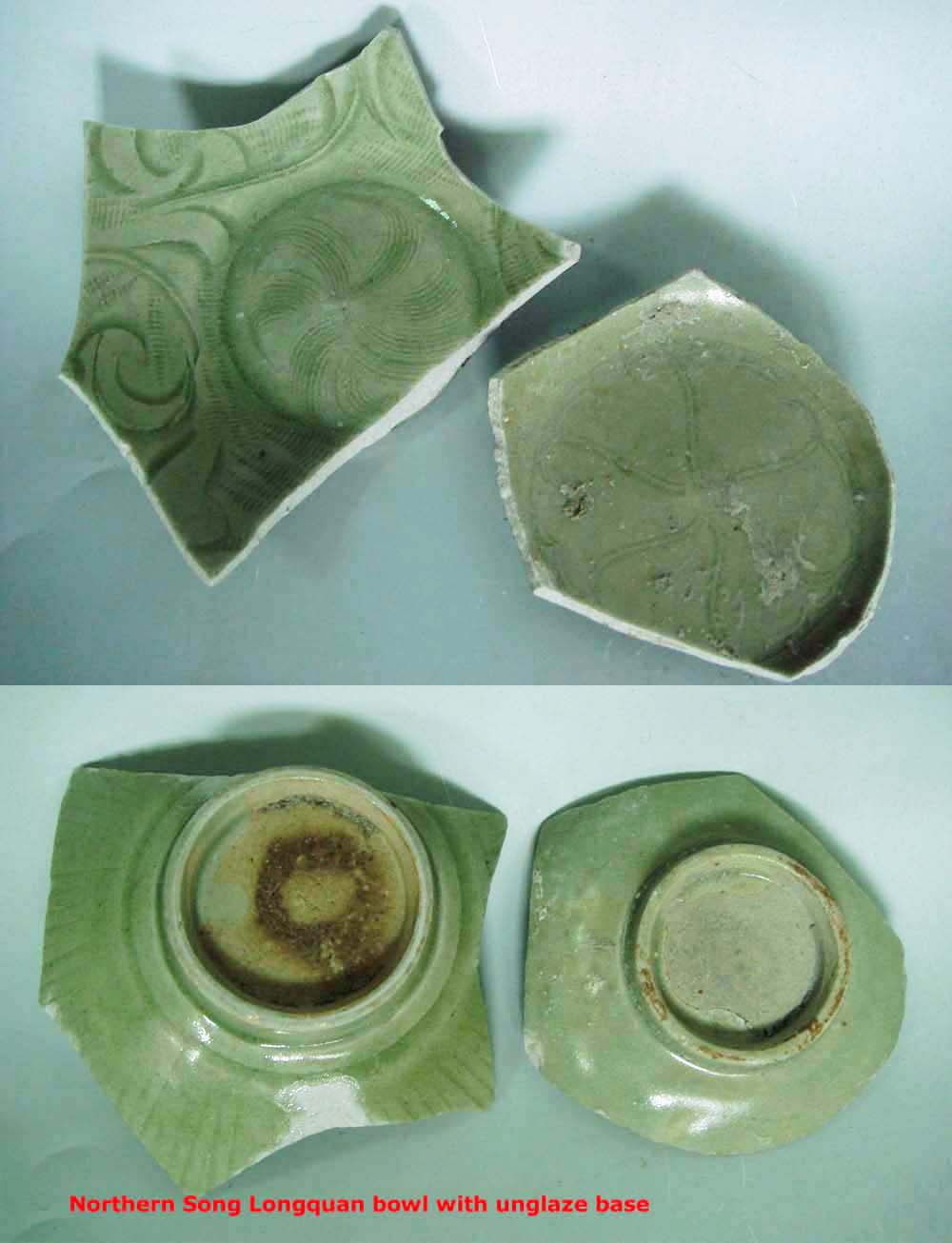
|
| Video clip of two Longquan celadon shards with carved/combed decoration |
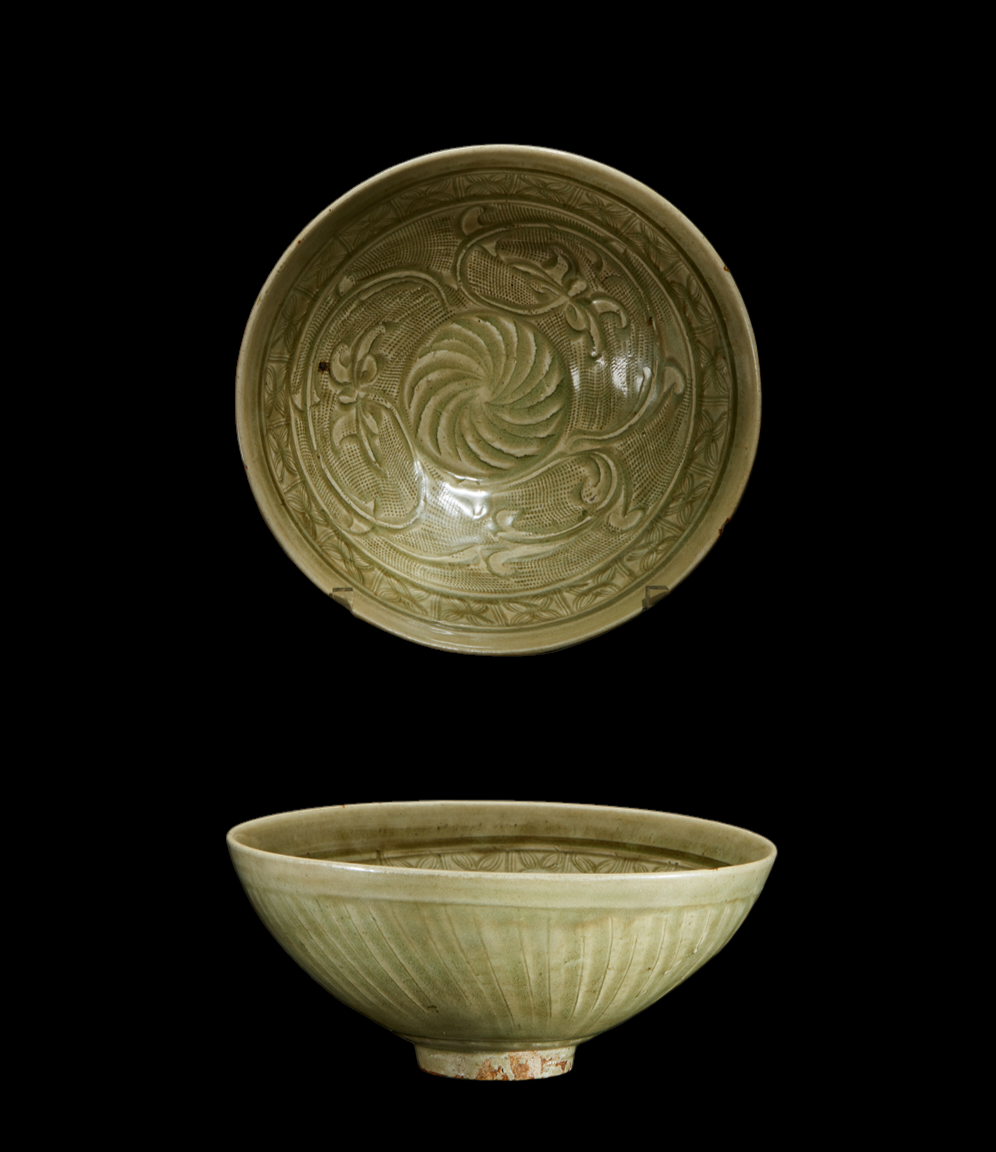 |
| Northern Song Longquan bowl unearthed from Zhejiang Wenzhou Shuomen ancient port site |
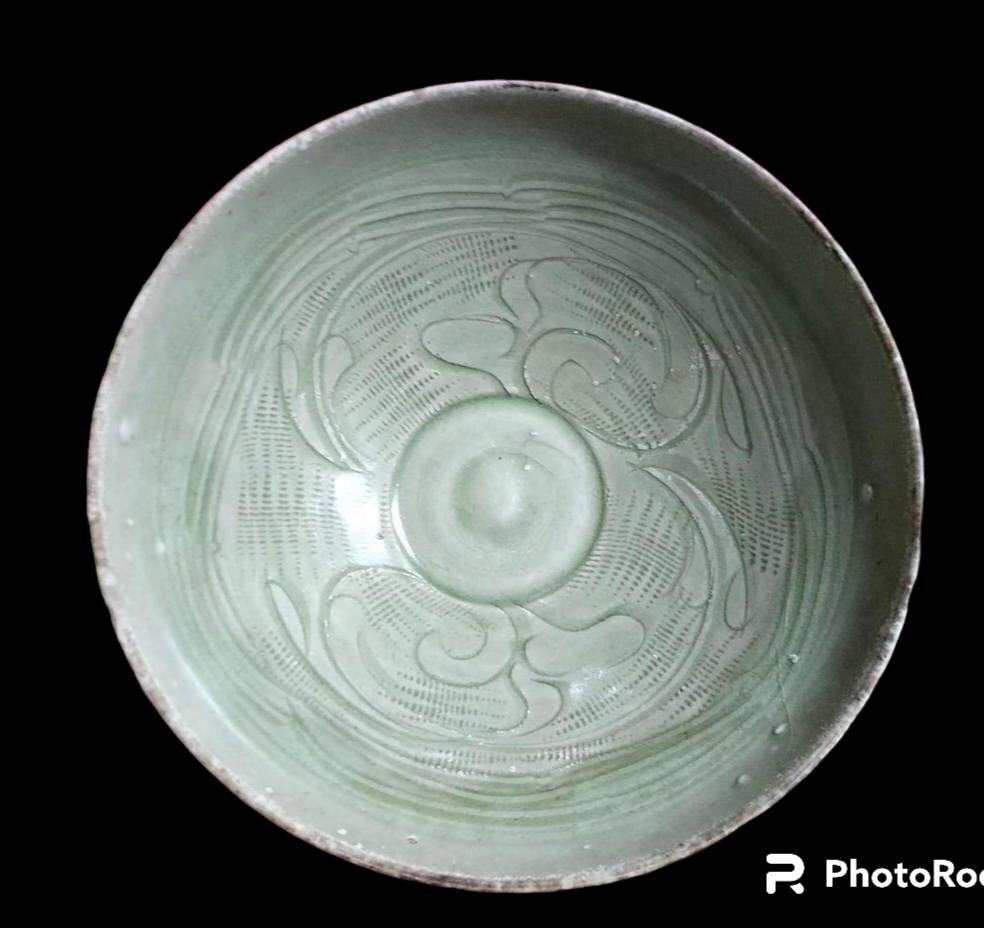 |
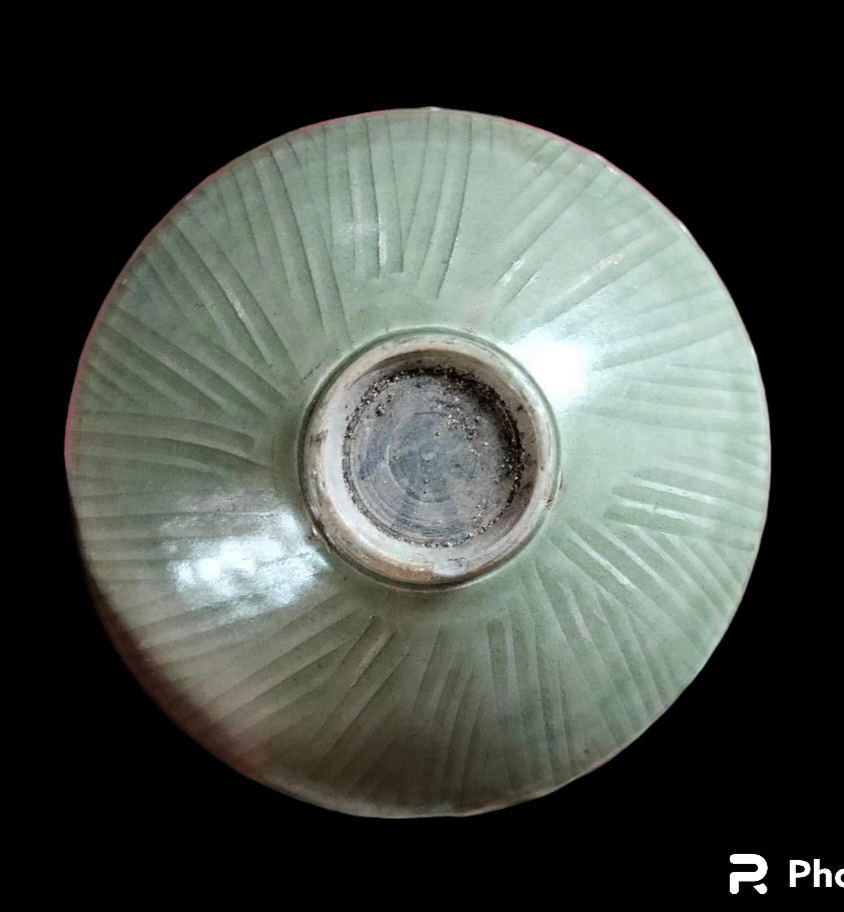 |
| Northern Song Longquan bowl recovered from river in Sumatra Jami |
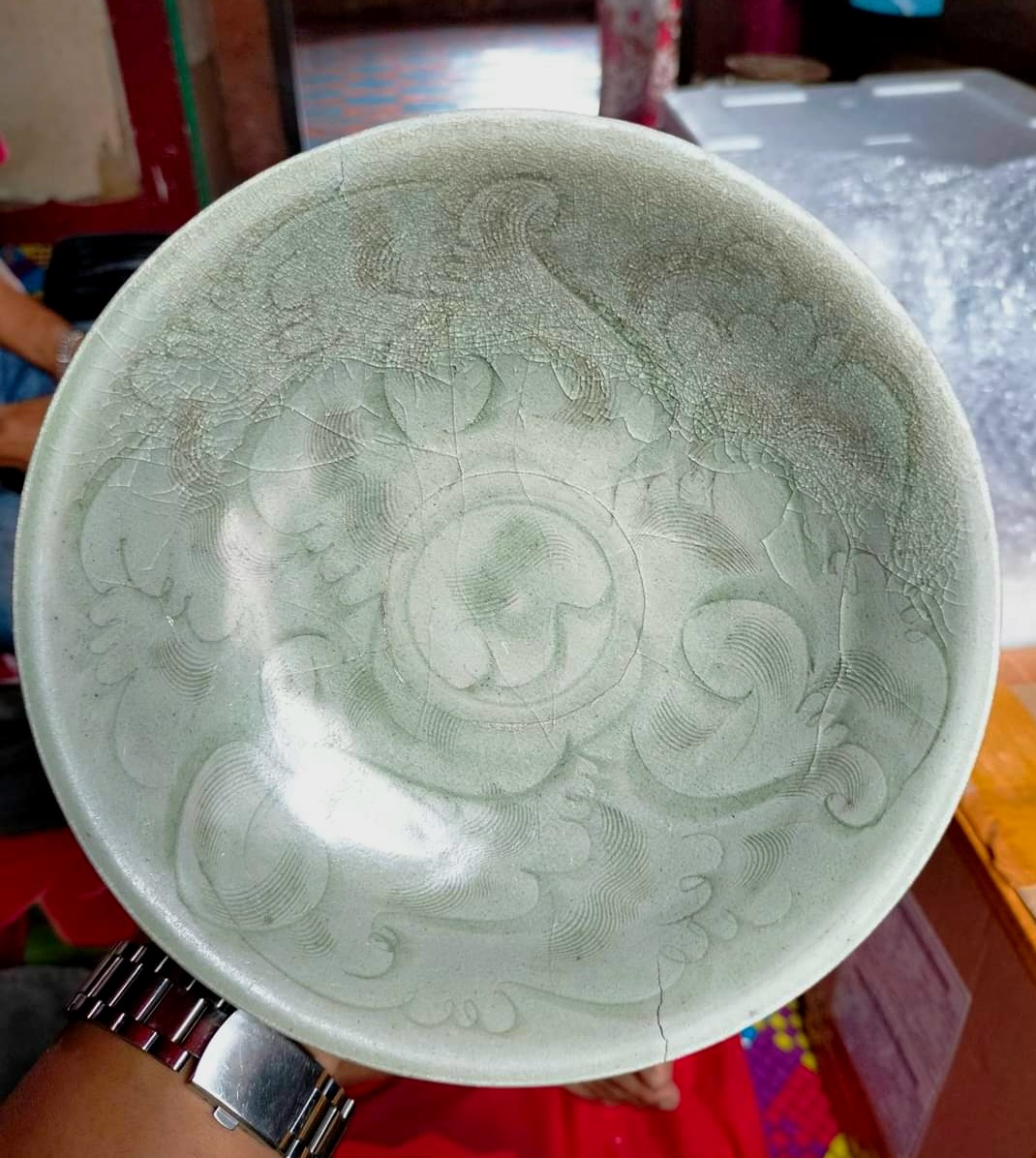 |
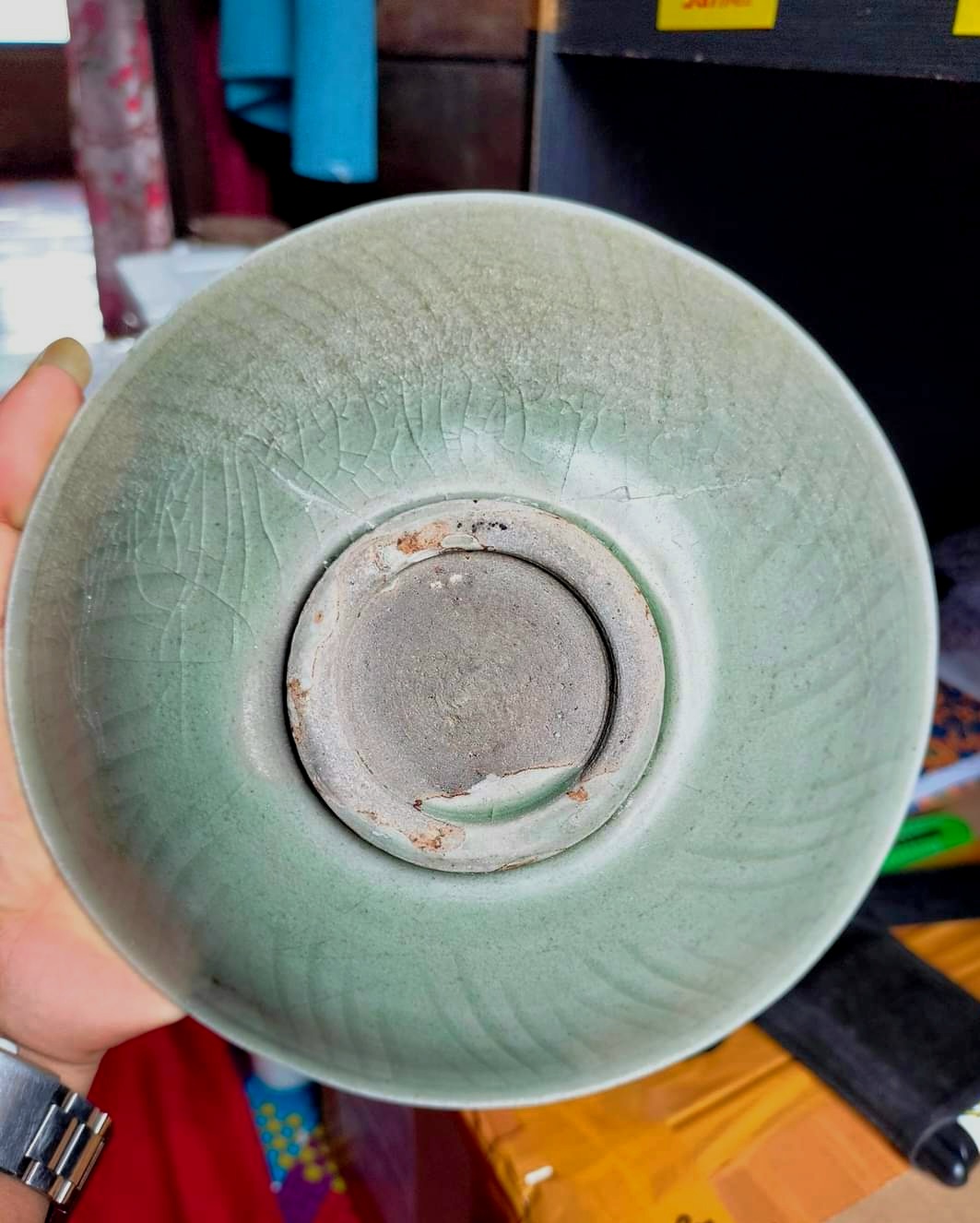 |
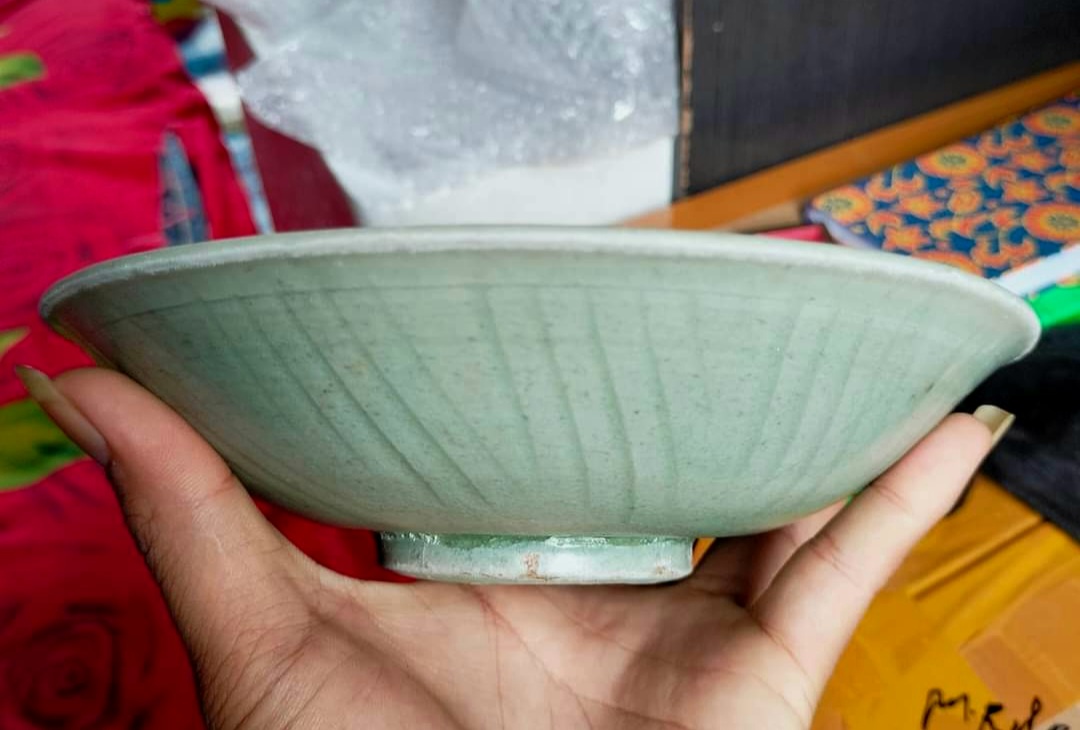 |
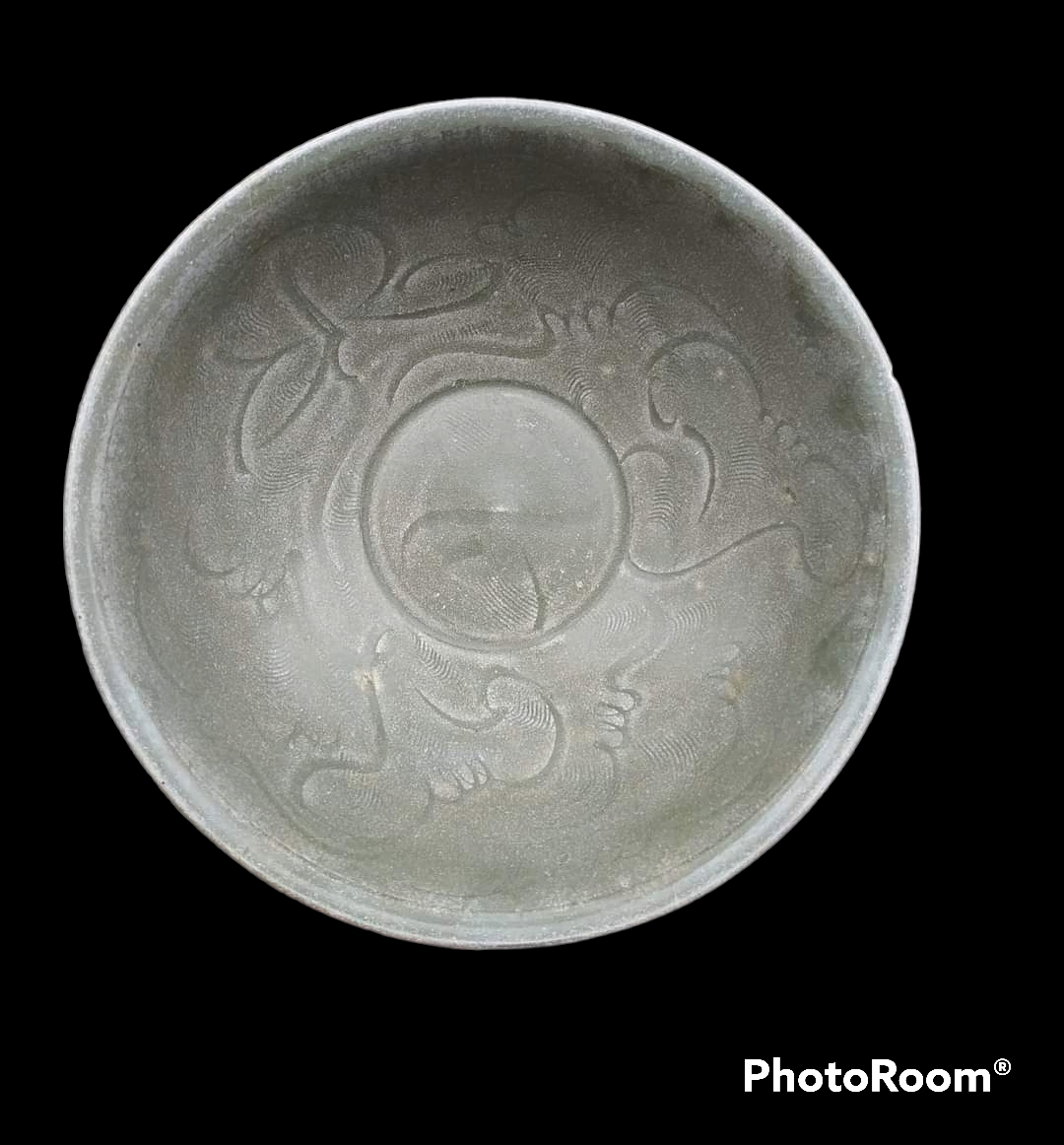 |
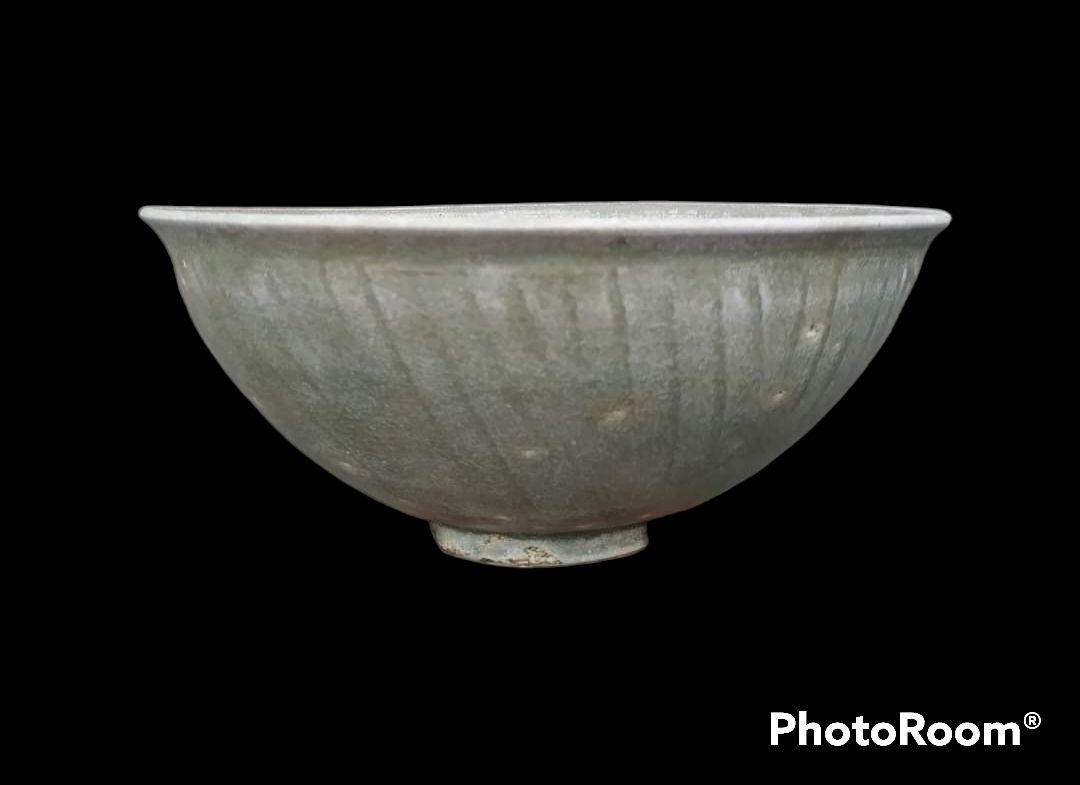 |
| Two early Southern Song examples with carved/combed abstract decoration found in Jambi |
Those bowls with carved/combed motif but without vertical carved lines on the external wall were introduced later. There were also those with stylised carved/combed lotus petals on the external wall.

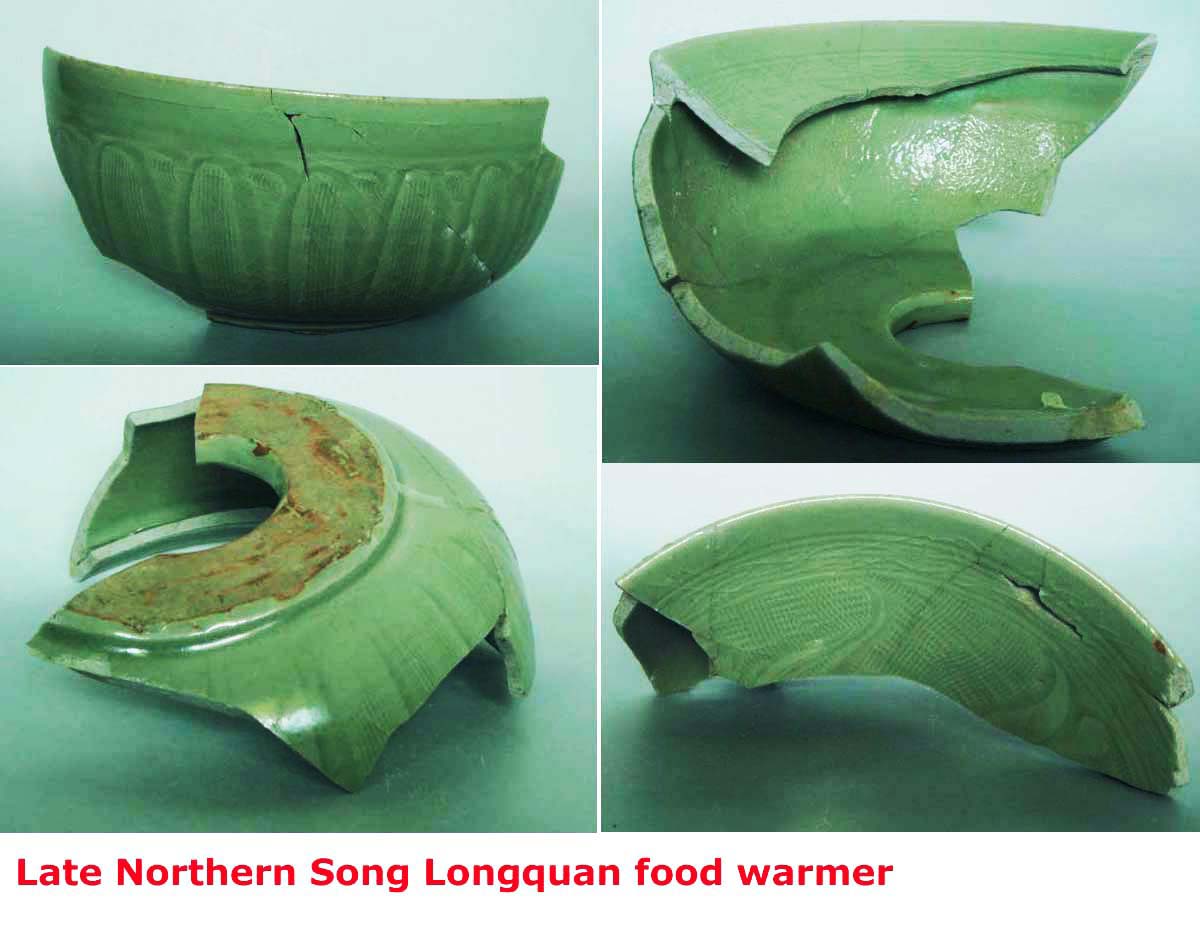
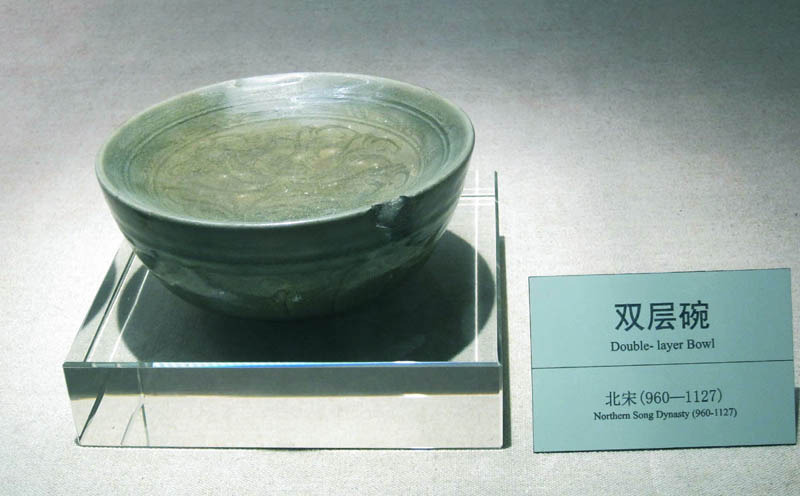
|
This category with combed lines in the lotus leaves are dated to late Northern Song/early Southern Song period |
|
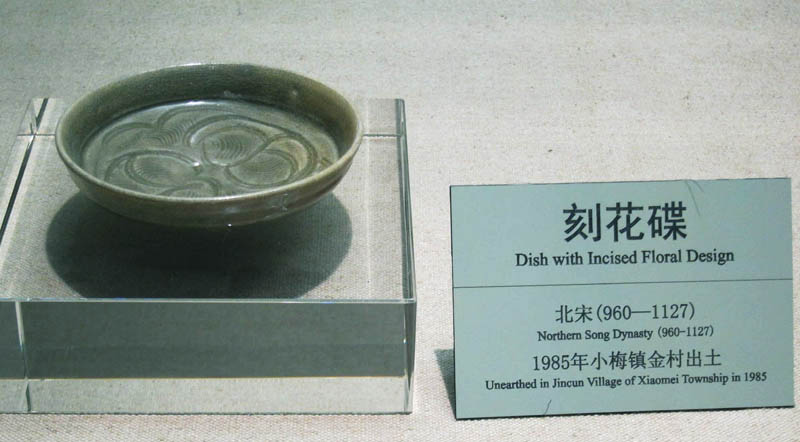
Many of the vases and bigger vessels were fired without the protection of the saggar. A distinctive Longquan vessel of this period is granary vase with tubular spouts on the shoulder. They were used as receptacle for grains used for ceremonial burial purposes. It symbolises prosperity for the descendents as in the local dialect , many tubular spouts (多角) sounds like much grains (多谷).
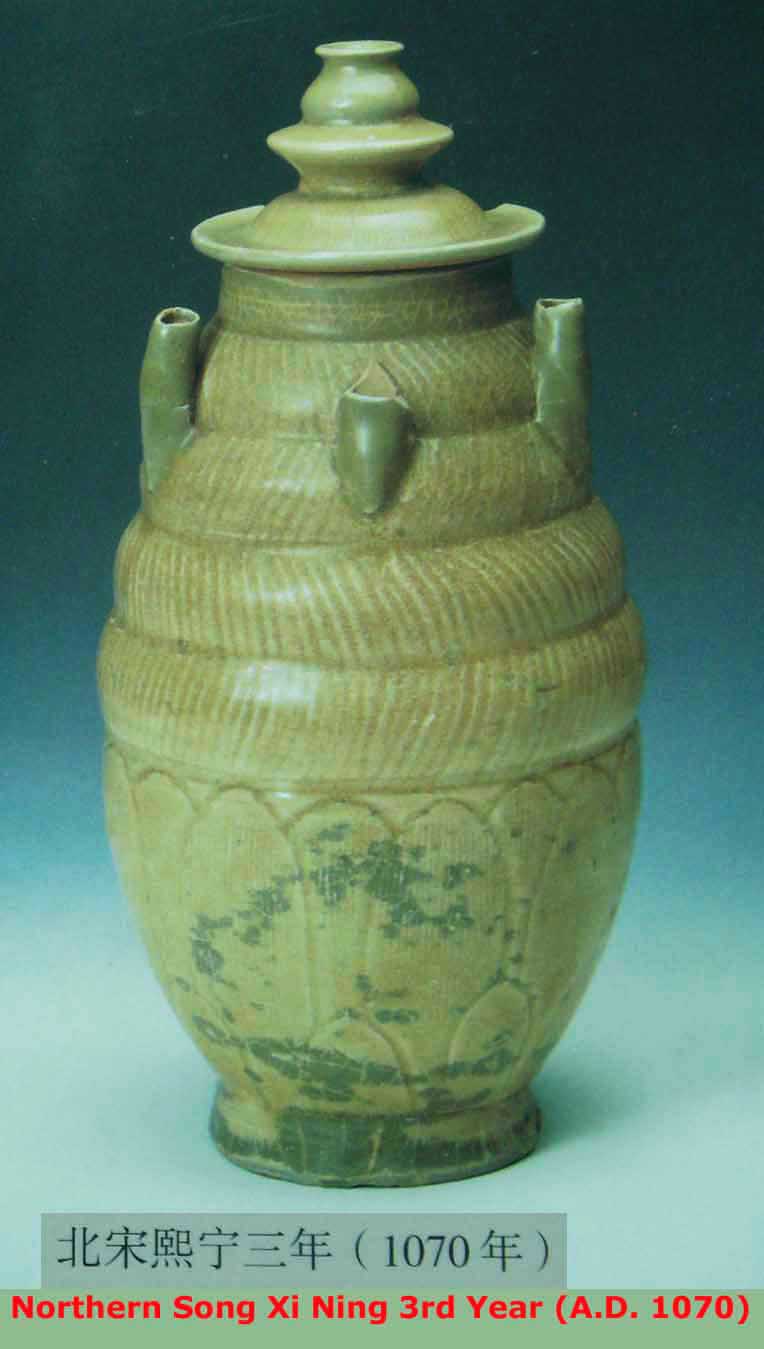
Another form of vase with dish-shape mouth was used as a wine vessel. A similar vase to that below in the collection of the Percival David Foundation has an inscription which states that wine was stored inside and prayer to the deceased for prosperity, longevity and peace to the descendents.
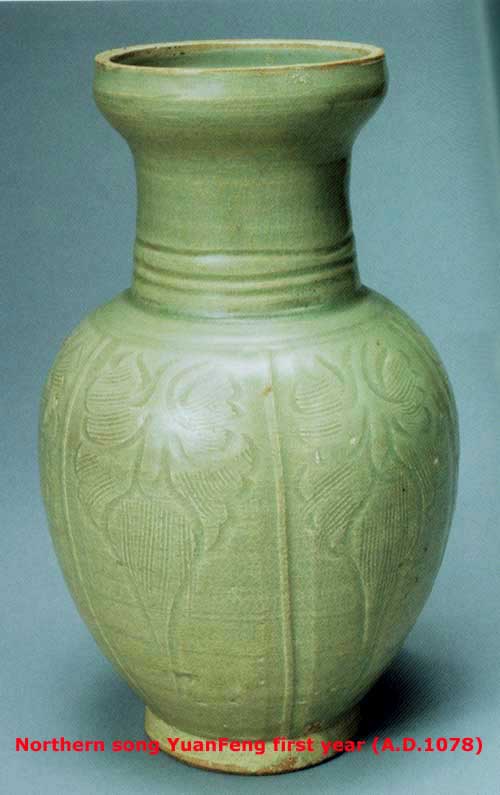
Early/Mid Southern Song Lonquan wares
During the early/mid Southern Song phase (2nd quarter to end 12th century), the typical bowl has a thick body and foot with unglaze outer base. The thick potting is necessary as the porcelain stone used contained a high silicon content. If too thin, the vessel would warp under high firing temperature. Decoration is typically more sparse and combed lines have practically disappeared. Carved lotus decoration was particularly popular. A new composition with stylised floral motif separated by a elongated "s" shaped lines was also introduced.
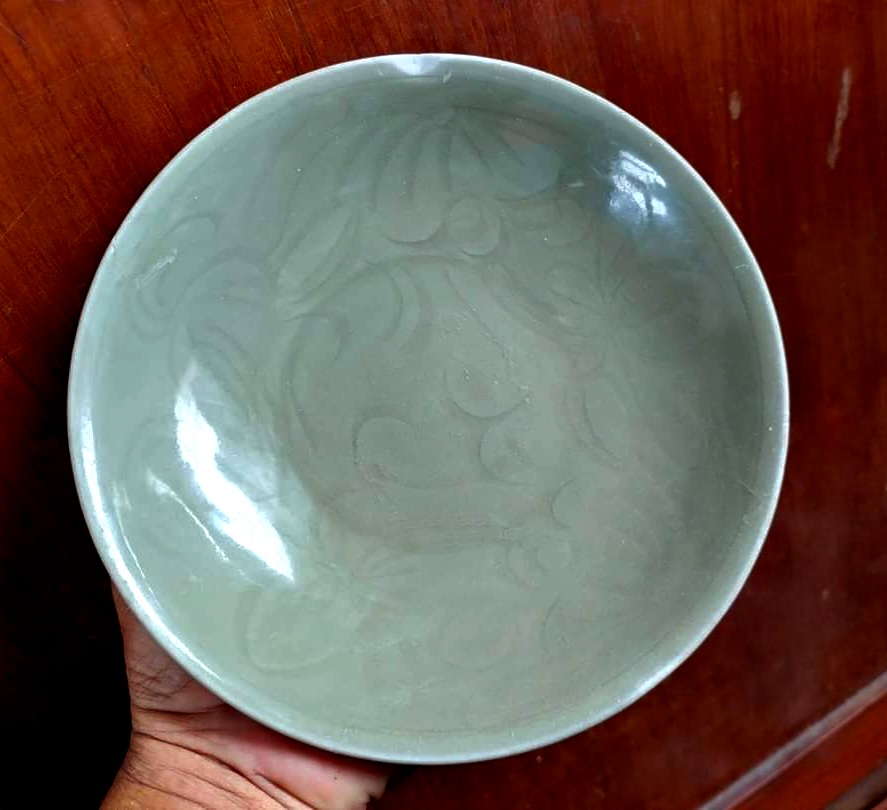
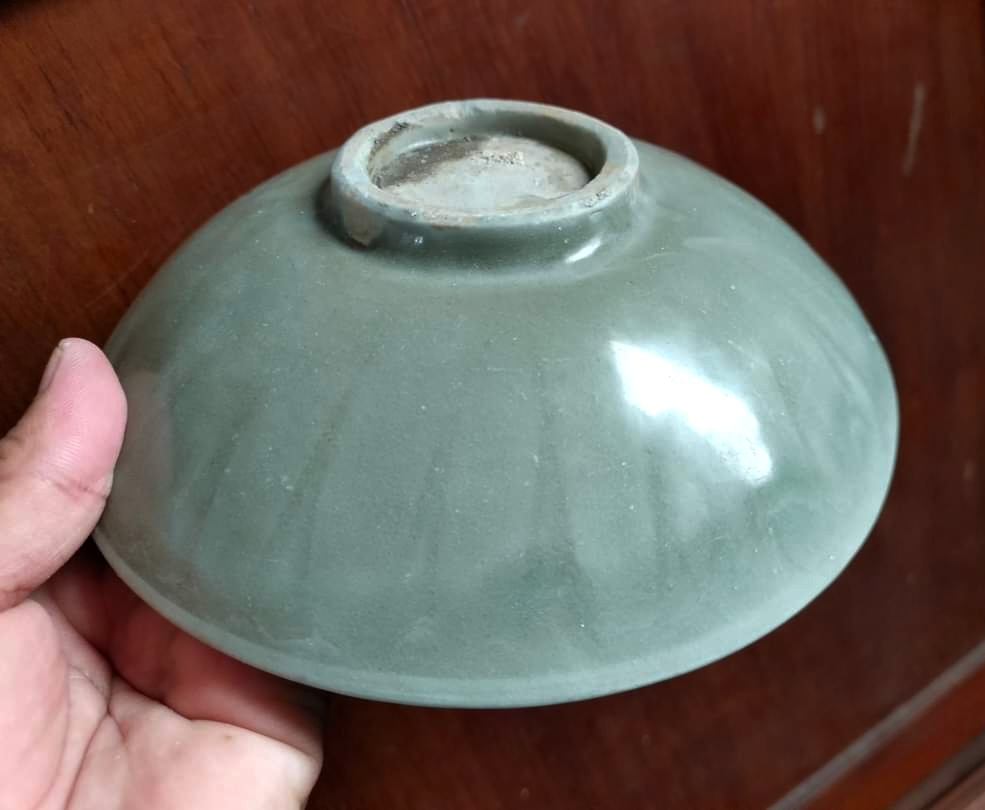
A good quality example with carved lotus decoration found in Jambi
For those who are familiar with Longquan export wares, they will observe that those from the Northern Song period are seldom encountered in overseas ancient habitation and burial sites. Longquan wares only started to appear in large quantity in the overseas market from the Southern Song period onward. Those bowls with the carved lotus or stylised floral motif with the 'S" separator were the earliest Longquan wares excavated in substantial quantities in ancient southeast Asia habitation and burial sites. Information from excavation of the kiln sites indicates that bowls and plates constituted the bulk of the production. The Nanhai 1 shipwreck dated to the early Southern Song period carried bowls with similar motifs.
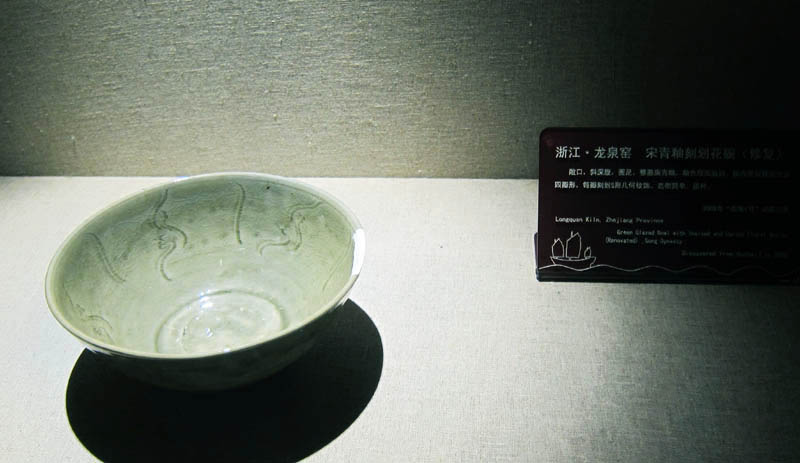
Longquan bowls from the Nanhai 1 shipwreck
According to Mr Kamei Meitoku, both the bowls with the lotus and the "s" shape line appeared to have a long production life. Similar types were recovered from the Dazaifu site which yielded a wooden slip with a date of A.D 1224. This is not unusual in ancient ceramics production history. Usually there is a phase when older types persisted while new product range was introduced.
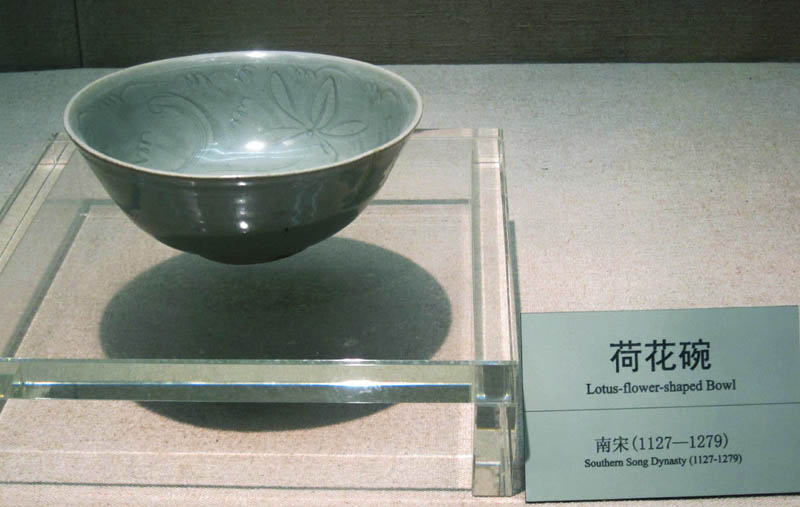
Bowl in Longquan Museum
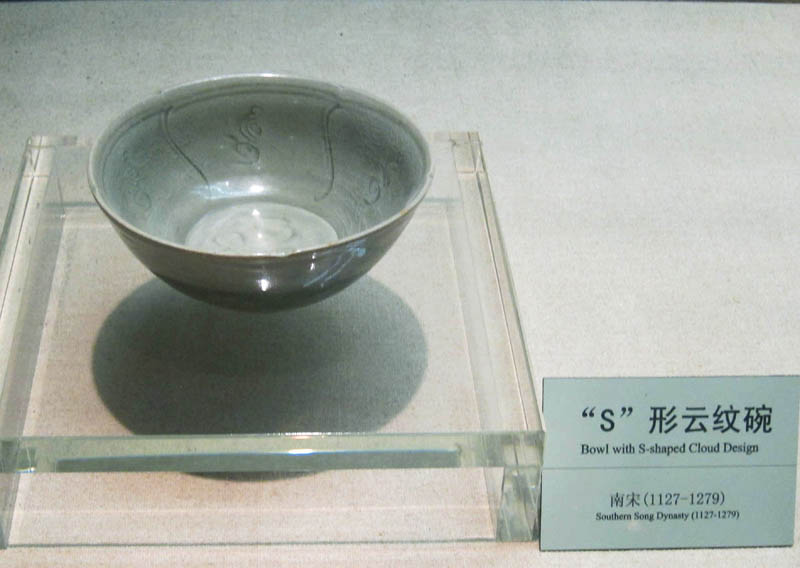
Bowls in Longquan Museum
|
|
|
|
Dish with the lotus motif. The external wall is carved with lotus with combed lines |
|
In the Indonesia Jepara shipwreck, there are some bowls with the "s' separator which are very similar to those found in the kilns in Da Baian (大白岸) in Eastern Longquan region. In the wreck, there are also many Fujian manufactured bowls with the Lotus motif. In comparison to the Longquan version, the finishing is less refine and the footring more rough. The wreck is dated to about later half of the 12th Century.
|
An example of Longquan bowl with the "s" separator and stylised floral motif from the Jepara shipwreck |
|
|
An example of Fujian bowl with the lotus motif from the Jepara shipwreck |
|
|
More examples of Longquan carved motif of the early Southern Song period. The small fragment of the rim of the example on the foreground is carved with more elaborate lotus motif |
|
There is also a popular type with an impressed inscription on the interior base which reads 河滨遗范 " hebinyifan" (river bank legacy) or 金玉满堂 |jingyumantang" (gold jade filled hall) . The origin of the inscription 河滨遗范 could be traced to an ancient event. Shun (舜), one of the 5 emperors of prehistoric China, was said to have made pottery in Hebin. The term hebinyifan was in commemoration of the contribution of emperor shun. From pieces found from dated graves, they were produced from around A.D 1180s onward.
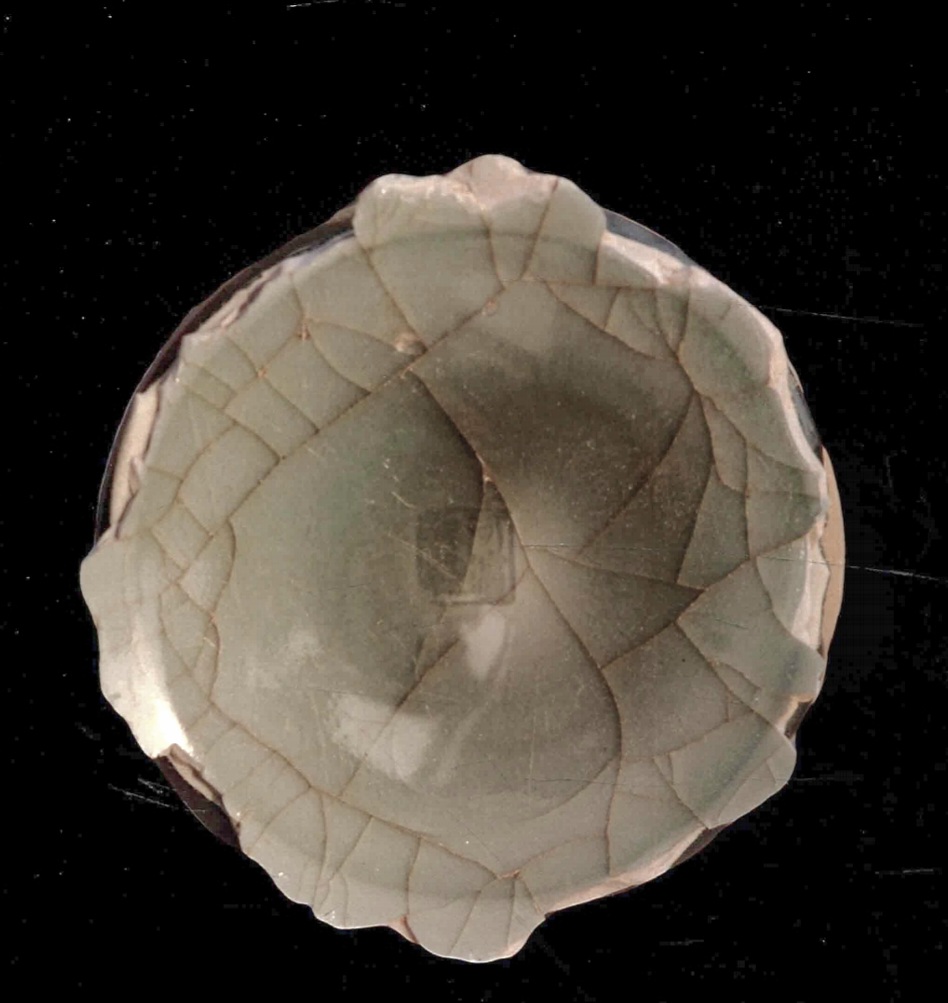 |
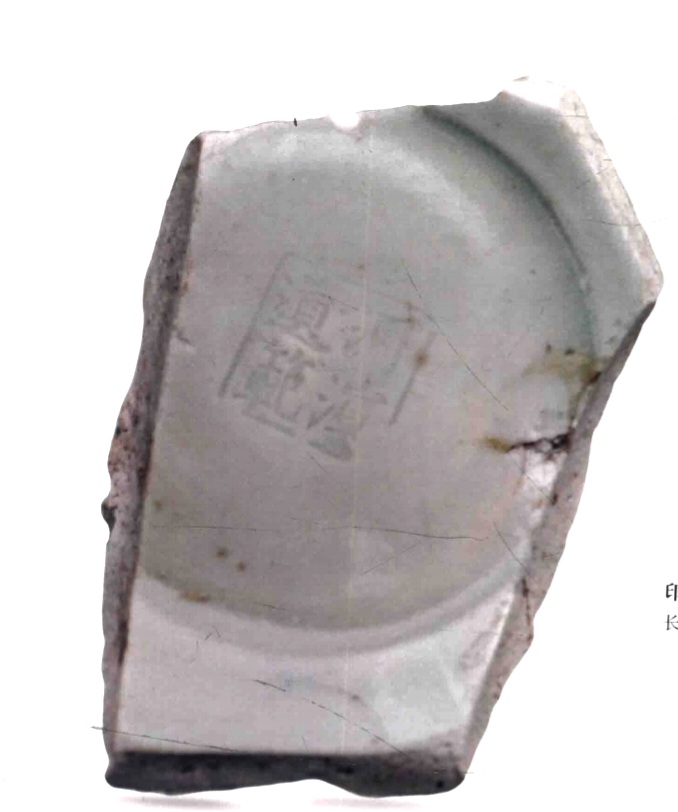 |
| Shards with 河滨遗范 " hebinyifan" (river bank legacy) |
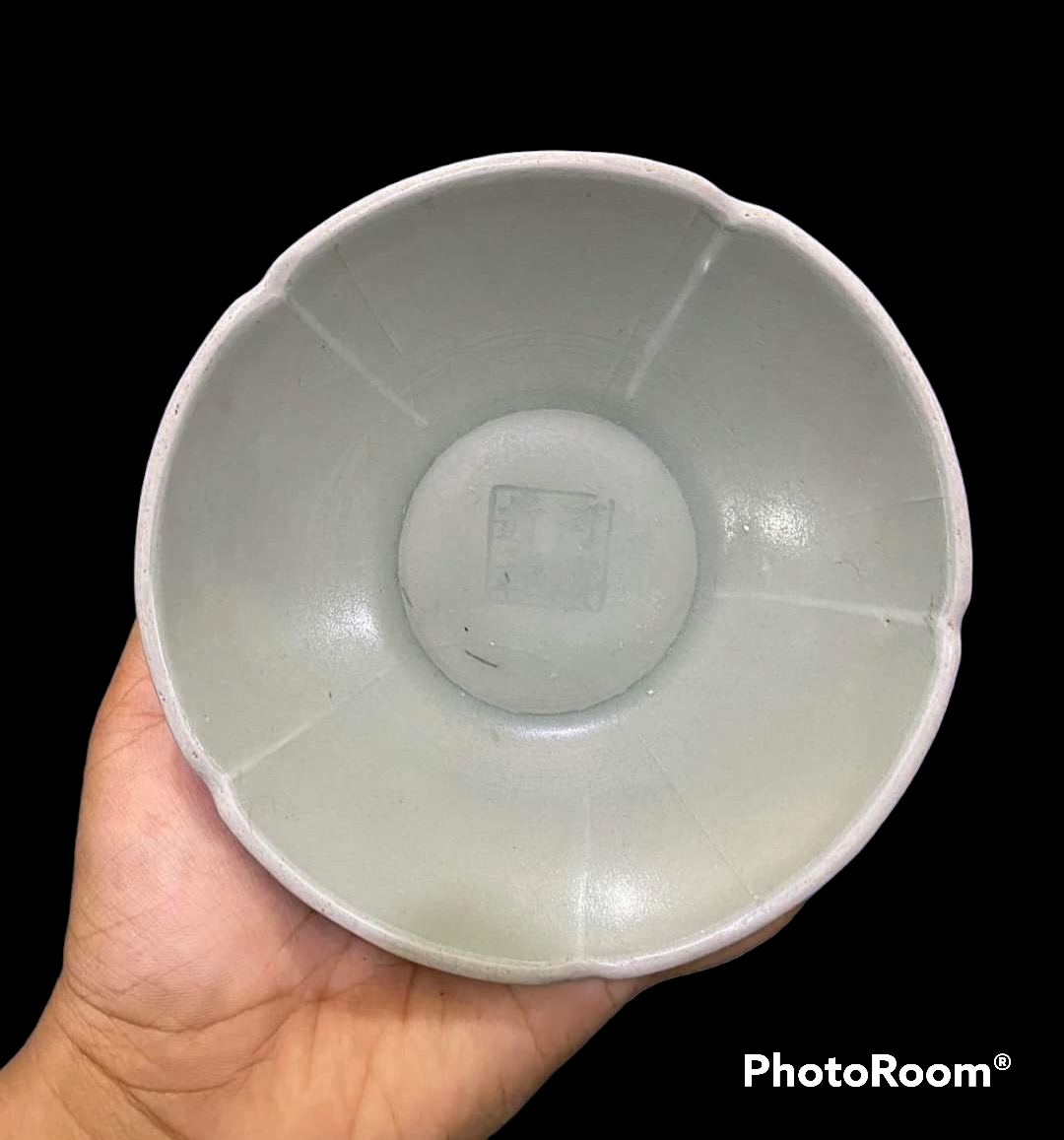 |
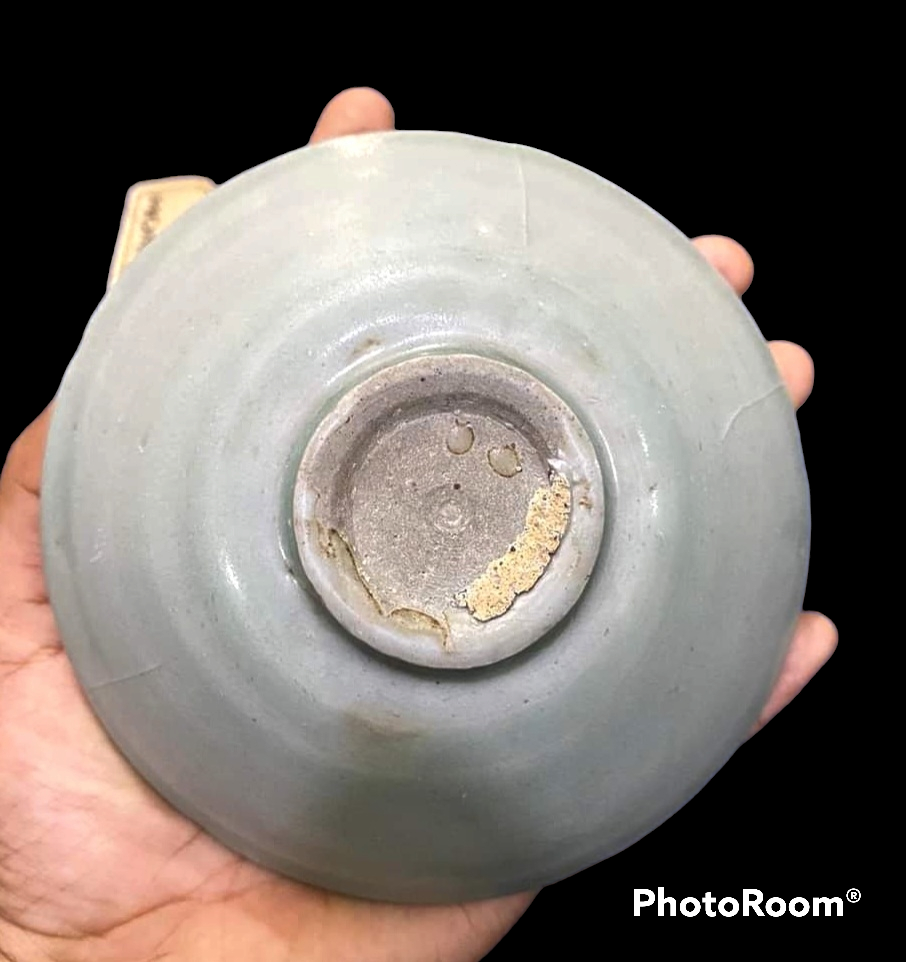 |
| Bowl with 河滨遗范 " hebinyifan" (river bank legacy) found in Jambi |
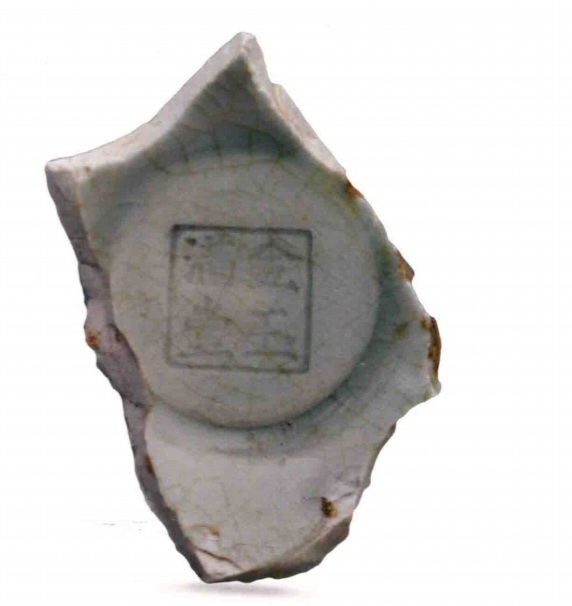 |
|
|
| Shards with 金玉满堂 |jingyumantang" (gold jade filled hall) |
A very popular type of bowls/plates/dishes with lotus petal carvings on the exterior were introduced sometime around late 12th/early 13th century. The lotus petal has a raised ridge The vessels have thick foot and unglaze outer base. They continued to be produced during early Yuan period. During the second half of 13th century, a more refined version was introduced. It has more thinly potted wall, well trimmed thin foot and more slender carved lotus on external wall.
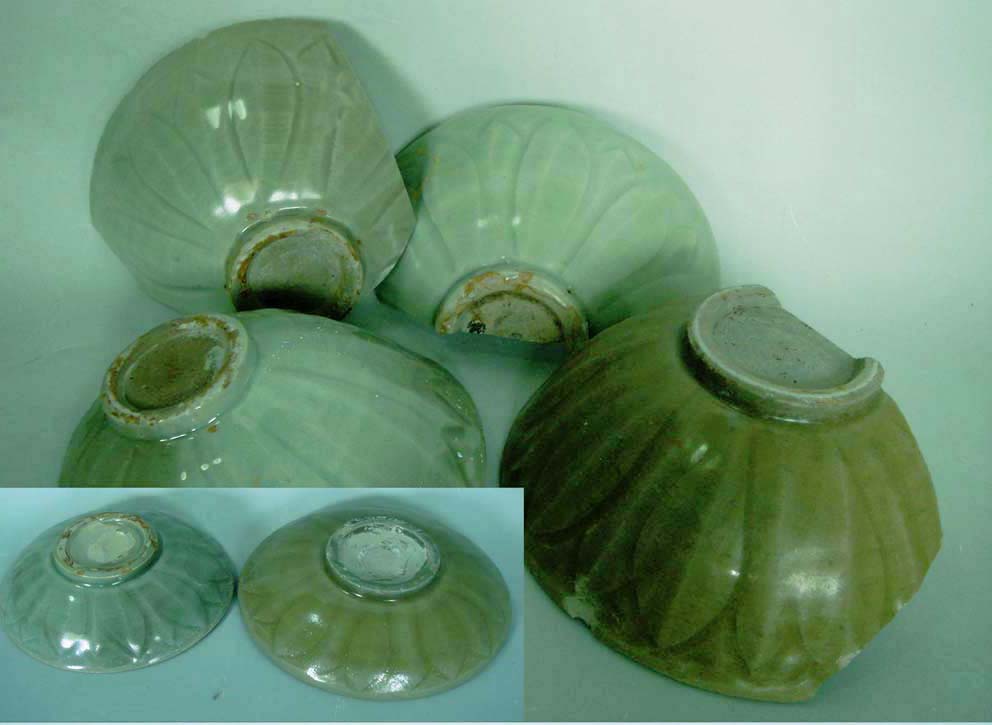
Examples with broad carved lotus petals and thick unglaze foot
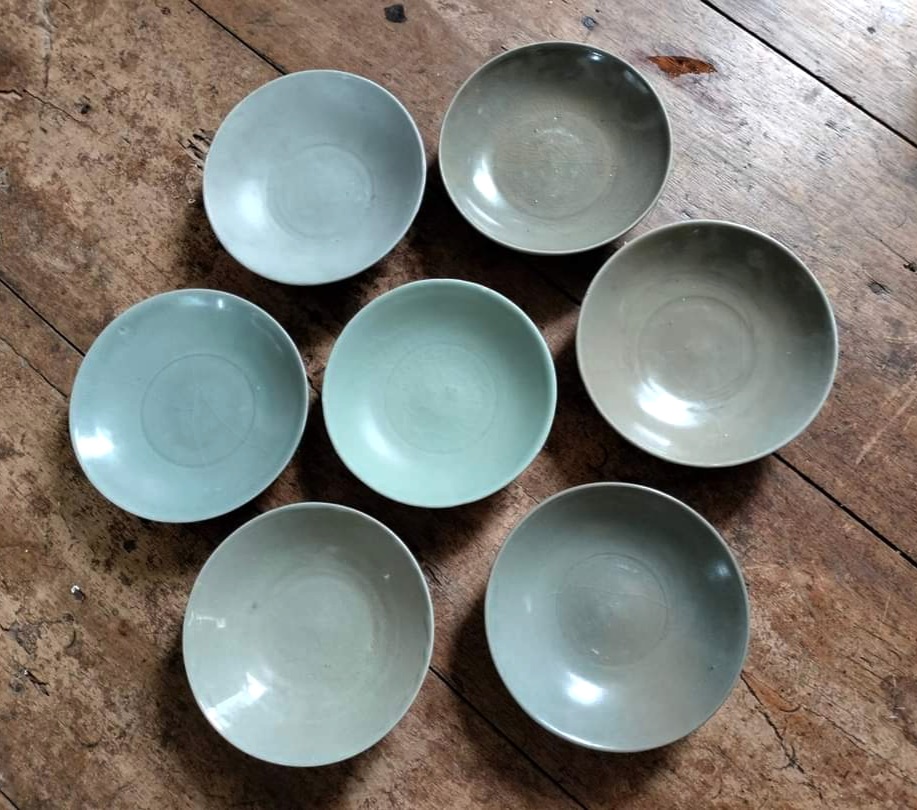 |
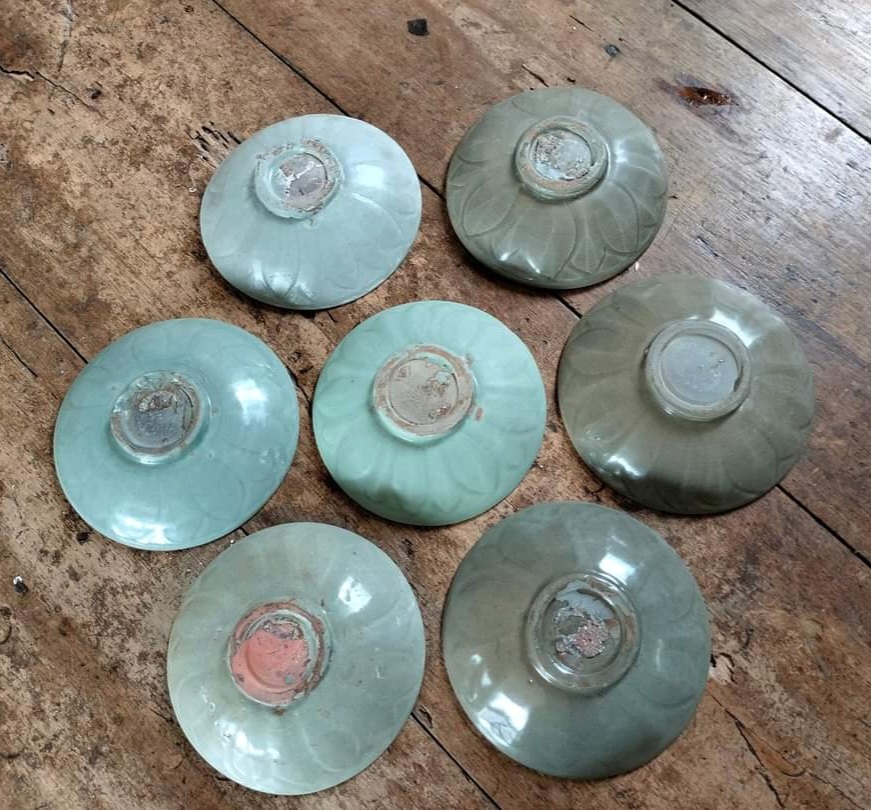 |
| Group of examples with the lotus petals decoration found in Jambi |